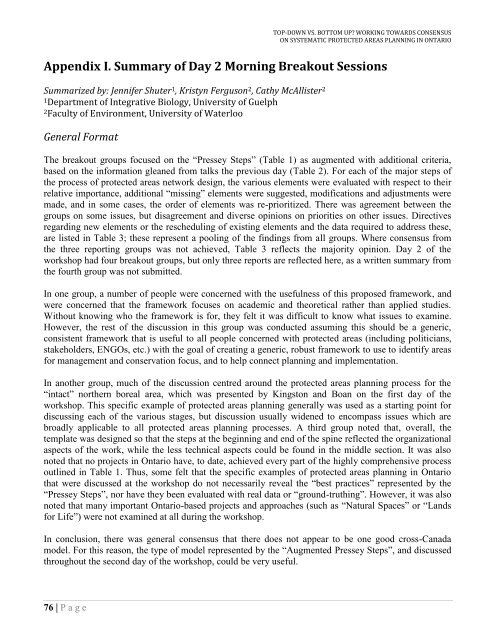Top-Down vs. Bottom Up: Working Towards Consensus ... - CASIOPA
Top-Down vs. Bottom Up: Working Towards Consensus ... - CASIOPA
Top-Down vs. Bottom Up: Working Towards Consensus ... - CASIOPA
- No tags were found...
Create successful ePaper yourself
Turn your PDF publications into a flip-book with our unique Google optimized e-Paper software.
TOP-DOWN VS. BOTTOM UP? WORKING TOWARDS CONSENSUSON SYSTEMATIC PROTECTED AREAS PLANNING IN ONTARIOAppendix I. Summary of Day 2 Morning Breakout SessionsSummarized by: Jennifer Shuter 1 , Kristyn Ferguson 2 , Cathy McAllister 21 Department of Integrative Biology, University of Guelph2 Faculty of Environment, University of WaterlooGeneral FormatThe breakout groups focused on the “Pressey Steps” (Table 1) as augmented with additional criteria,based on the information gleaned from talks the previous day (Table 2). For each of the major steps ofthe process of protected areas network design, the various elements were evaluated with respect to theirrelative importance, additional “missing” elements were suggested, modifications and adjustments weremade, and in some cases, the order of elements was re-prioritized. There was agreement between thegroups on some issues, but disagreement and diverse opinions on priorities on other issues. Directivesregarding new elements or the rescheduling of existing elements and the data required to address these,are listed in Table 3; these represent a pooling of the findings from all groups. Where consensus fromthe three reporting groups was not achieved, Table 3 reflects the majority opinion. Day 2 of theworkshop had four breakout groups, but only three reports are reflected here, as a written summary fromthe fourth group was not submitted.In one group, a number of people were concerned with the usefulness of this proposed framework, andwere concerned that the framework focuses on academic and theoretical rather than applied studies.Without knowing who the framework is for, they felt it was difficult to know what issues to examine.However, the rest of the discussion in this group was conducted assuming this should be a generic,consistent framework that is useful to all people concerned with protected areas (including politicians,stakeholders, ENGOs, etc.) with the goal of creating a generic, robust framework to use to identify areasfor management and conservation focus, and to help connect planning and implementation.In another group, much of the discussion centred around the protected areas planning process for the“intact” northern boreal area, which was presented by Kingston and Boan on the first day of theworkshop. This specific example of protected areas planning generally was used as a starting point fordiscussing each of the various stages, but discussion usually widened to encompass issues which arebroadly applicable to all protected areas planning processes. A third group noted that, overall, thetemplate was designed so that the steps at the beginning and end of the spine reflected the organizationalaspects of the work, while the less technical aspects could be found in the middle section. It was alsonoted that no projects in Ontario have, to date, achieved every part of the highly comprehensive processoutlined in Table 1. Thus, some felt that the specific examples of protected areas planning in Ontariothat were discussed at the workshop do not necessarily reveal the “best practices” represented by the“Pressey Steps”, nor have they been evaluated with real data or “ground-truthing”. However, it was alsonoted that many important Ontario-based projects and approaches (such as “Natural Spaces” or “Landsfor Life”) were not examined at all during the workshop.In conclusion, there was general consensus that there does not appear to be one good cross-Canadamodel. For this reason, the type of model represented by the “Augmented Pressey Steps”, and discussedthroughout the second day of the workshop, could be very useful.76 | P a g e


